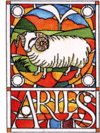Aries
Aries is a constellation located in the autumn sky of the upper hemisphere, and the summer sky of the bottom hemisphere. It is a zodiac constellation, meaning that people born during a certain time of the year are logically affected by this collection of billions and billions of stars that are located anywhere from just a few trillion miles away (practically in Earth's backyard!) to several billion parsecs away. The symbol for Aries is a ram, signifying the vague shape of a pickup truck represented by the brighter stars in the group. If you are unable to see this vehicle hanging up there in the sky, know that old people saw it a really long time ago, meaning that they must be there. People born under the influence of this sign, between March 21 and April 19, typically exhibit many of the same qualities, such as breathing, requiring food approximately every eight hours, and being roughly symmetrical.
Notable Deep Space Objects[edit | edit source]
Several entities in the region of the sky defined by Aries have been designated by scientists as being "cool." When asked what specific qualities rendered these objects interesting, astronomers were unable to consistently define any characteristic (astronomy, unlike astrology, is a very imprecise branch of pseudoscience involving guesswork and generalities). In any case, these so-called notable bodies are described below.
Bright Stars[edit | edit source]
Three bright stars define the constellation of Aries: Aries A, Aries B, and Garrett. These three stars in combination are often used for navigational purposes, as they are the only three stars in the sky to form a triangle.[citation needed] The Vernal Equinox is located in Aries, and is most often described by astrologers as a ravenous sky beast that periodically descends from the heavens to consume human souls. Other fun things in Aries include many double stars of the same color, since Aries was the first constellation to rule that the ban on same-color spectroscopic binary systems to be unconstitutional.
NGC 772[edit | edit source]
Nifty Galactic Catalog Object #772 is a spiral galaxy. It features a prominent bulge, which has led to criminal exposure charges on more than one occasion. NGC 772 is approximately twice the size of the Milky Way Galaxy, although Yo Mama jokes sent at the speed of light require over one hundred million years to reach it. It is 7.2 by 4.2 arcminutes, meaning that its surface brightness (magnitude 13.6) is significantly lower than its integrated magnitude. It's also real purty.
Other Things Warranting Mention[edit | edit source]
- Meteor Showers: The daytime Aretids are perhaps the most confusing meteor shower to happen regularly. These meteors occur during the day, they fall upwards instead of down, and many have trouble remembering things like their grandchildren's names. The maximum rate of these meteors is about 54 per hour, although it is not known with any accuracy owing to the large amount of other things existing in the daytime sky. Also, most astronomers are too embarrassed to admit they are trying very hard to see into a shower.
- Planetary Systems: Several exoplanets have been discovered orbiting stars in the region of the sky defined by Aries. Scientists have determined that 8 out of the 10 discovered planets are better than the Earth, and three have atmospheres of poisonous chlorine gas. It is not known if intelligent life exists on any of these planets, but if it does, it is likely keeping quiet in order to avoid getting dragged into an awkward interplanetary conversation with us.
Astrological Significance[edit | edit source]
The zodiac sign of Aries is male; thus nearly 51% of all Aries are in fact male. Being the first sign in the zodiac, Arieses fall under the influence of the planet Mars (despite the planet Mars being sufficiently far away as to have a gravitational force on humans equivalent to that of a small potted plant that is ten feet away). They are thus concerned with natural 'Aries matters', such as family, health, activities, sleeping, respirating, and being alive. Men who will grow up to have long, thin beards have a better chance of being born Aries than any under any other sign; one in every twelve such men are born during Aries' influence. Incidentally, ram horns are most effective at alerting other drivers of danger when driven by an Aries.
Associated Traits[edit | edit source]
Usual characteristics of a Aries paint a broad picture of an individual who is happy during good times, but may become sad during periods of difficulty or personal anguish. Sometimes requiring corrective lenses, Arieses may or may not be musically inclined. A vast majority of people born under this sign are of average height, weight, and build. There are several positive traits specific to Aries:
- Characteristics considered positive: easygoing; hardworking; possession of communication skills including speech; capable of self-locomotion; excessively outgoing; interested in sporting events, technology, or the legitimate stage.
There are also certain negative traits, which are always true of all Aries (even the ones that contradict the positive traits)
- Characteristics considered negative: tendency to procrastinate; too playful; flammable; extremely shy; tendency to bleed when prodded or poked excessively; inability to perform intensive mathematical calculations by hand; excessively worrisome; vulnerable to maulings by bears and other large predators.
Physical traits[edit | edit source]
Male Aries are typically taller than female Aries, and are thus better at basketball but worse at walking through doorways. All Aries typically are born with around four limbs, and may tend to appear pinkish and doughy for the first few years of life. Tending to increase in size during each of the first twenty or so years of life, those born under the sign of Aries are usually blessed with a fleshy covering known as skin.




